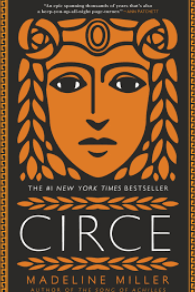“Circe” by Madeline Miller
Book critiques and reviews.

Cover depicting an illustration of main character Circe, Witch of Aiaia, daughter of Sun Titan Helios.
March 8, 2023
Growing up, I always had a soft spot for “Percy Jackson” and the very well-known Greek Mythology that is widely spread, originating thousands of years ago. With this, when this book was recommended to me, being a book of literature that includes Greek mythology, it piqued my interest to new heights.
Wow, it did not disappoint.
The book centers around Circe, the daughter of the Sun Titan, Helios. Circe is believed to be a nymph, powerless and deemed ugly by her siblings. When it is shown that she and her siblings have the first-ever known abilities of Witchcraft however, she is deemed a threat to Zeus and is banished to an empty island.
It is here where she hones her craft and finds herself in the presence of many famous heroes as the years go on. The book delves into the stories of Daedalus and Icarus, Prometheus, the minotaur, and many others that Circe connects with throughout her life.
I was worried this book might be slow, as many books like this are, but it hooked me right off the bat. It didn’t waste any time in delving into Circe’s story, and I felt that I connected strongly with Circe’s character. Although she may be a nymph and daughter of a Titan, her character is created to be deeply human – and I felt this presented a new way to view these characters from this ancient mythology.
Many others who have read this book have felt similar, as “Circe” was awarded Goodreads Choice Award for Best Fantasy, and was long-listed for the Andrew Carnegie Medal for Excellence.
Alexander Alter from the New York Times said “‘Circe’ is a bold and subversive retelling of the goddess’s story that manages to be both epic and intimate in its scope, recasting the most infamous female figure from ‘The Odyssey’ as a hero in her own right.”
Many know of the famous story “The Odyssey” written by Homer, where Circe is presented in a way that could only really be deemed as male-gaze orientated. She is seductive and lustrous, and only presented to prevent Odysseus from returning home.
In Madeline Miller’s interpretation, she is less of a seductress and instead a complex goddess, worthy of a backstory and intricacy. She is vicious and strong, and has the ability to give young women who read such a story hope that they are able to be more than an obstacle for men, but instead could be the hero themselves.
Miller also had written another very famous book similar to “Circe,” known simply as “The Song of Achilles” – which won the 2012 Orange Prize of Fiction as well as being a New York Times best seller.
“Circe,” in the end, lives up to every praise given to it by those who have had the chance to read the novel. I believe that not only is this book an easier read, but is a book that as a woman, I find easy to connect with through the basis that we are all innately human.


